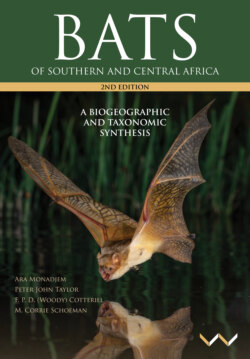Читать книгу Bats of Southern and Central Africa - Ara Monadjem - Страница 32
На сайте Литреса книга снята с продажи.
Ancient basement rocks
ОглавлениеThe very earliest of events that would come to control bat biogeography occurred as long as 3.8 billion years ago when the first continents – known as cratons – started to form on what was then a young planet. Ultimately, two of these, known as the Kaapvaal and Zimbabwe cratons, came to make up a large part of southern Africa. The granite-greenstone terrain that makes up these cratons contains some of the oldest rocks on earth, as can be seen in the Barberton Mountain Land of South Africa.
The granites that characterise so much of Zimbabwe, and also dominate much of the topography and soils of southern Africa, exhibit a spectrum of ages of formation. The majority of the intrusions that ultimately weathered into Zimbabwe’s extensive granitic shield were formed 2,650 million years ago (hereafter Ma). By contrast, the Cape granites are much younger (∼550 Ma). Prolonged weathering and erosion (Twidale and Vidal Romani 2005) has led to the diversity of landforms characteristic of such exposed granites (e.g. in the Matobo Hills of Zimbabwe, Cotterill (2018a)). The rich variety of these granitic landforms has a strong influence on the soils, hydrology, and vegetation of these landscapes (Whitlow 1980, 1982, Moore et al. 2009) (Figure 22).
Figure 21. Aerial view over the granitic shield near its southwest edge in the Matobo Hills, Zimbabwe. Its crevices, caves, and woodlands provide a rich variety of daylight domiciles for roosting bats (Cotterill 2018a, b) (© F. P. D. Cotterill).
Figure 22. The rugged landscape of the extensive granitic shield extends from the Tete Province of Mozambique south across eastern and southern Zimbabwe to the Matobo Hills into southeastern Botswana. The most spectacular examples of inselbergs dominate the catchments of the Ruenya and Mazowe rivers in northeast Zimbabwe (here in the Mudzi district). The vegetation is diverse across the rocky slopes, especially where it is protected from fires. Miombo woodland dominates, although it has been largely destroyed by agriculture and settlement on arable lands. These large trees, granite kopjes and inselbergs (dwalas) provide abundant roosts for many species of bats. Here in northeastern Zimbabwe (70 km north of Mutoko), the rarely encountered molossids Tadarida fulminans and T. lobata are locally common (Cotterill 2001b) (© F. P. D. Cotterill).
The ecological importance of granites is demonstrated in roost selection by the large molossid bats Tadarida fulminans, T. lobata, and T. ventralis. The distributions of these species are closely associated with crevice roosts in granite precipices, and to a lesser extent in Karoo sandstones and basalts (Cotterill and Fergusson 1993, Cotterill 2001b).
